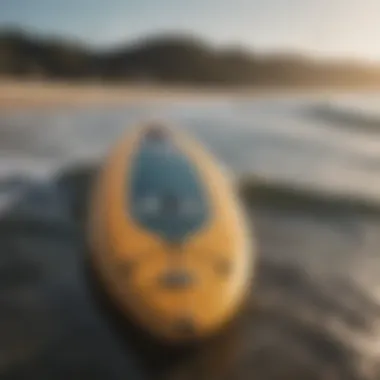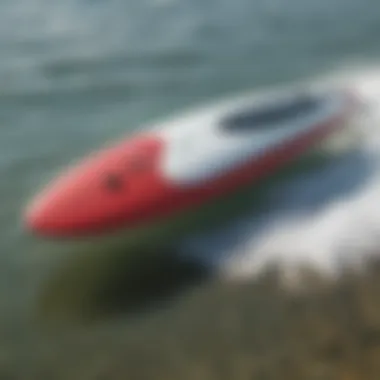Cost Breakdown of Hydrofoil Surfboards


Intro
Navigating the waters of hydrofoil surfboards can feel a bit like trying to catch the perfect wave. With their unique ability to raise the rider above the water surface, they promise an exhilarating experience that has captured the attention of kiteboarding enthusiasts everywhere. But before you ride off into the sunset with one of these surfboards, it’s crucial to understand the financial landscape that surrounds them. The world of hydrofoil surfing is not just about the thrill; it’s also about the bucks you’ll spend.
In this article, we will dive into various price points, explore what affects those prices, and how they stack up against traditional surfboards. Gaining insight into the costs associated with acquiring and maintaining hydrofoil gear can make a significant difference in your investment decisions. Whether you're just starting or you’ve already got some experience under your belt, understanding these financial aspects will equip you better for success out on the water.
Gear Insights
Latest Gear Reviews
Hydrofoil surfboards offer different functionalities and pricing. Some brands like Lift, Slingshot, and Naish have emerged as notable players in the market. Lift produces high-grade equipment known for its lightweight design and durability, ideal for both novice and seasoned riders. On the other hand, Slingshot offers a range of boards that cater to varied skill levels, making it easier for beginners to transition smoothly.
For instance, the Lift 4'8" hydrofoil surfboard can cost around $1,900, while Slingshot's comparable model might fall within the $800-$1,200 range. The performance features, build quality, and user reviews should guide you in making an informed choice. Consulting community forums on platforms like Reddit can provide real-world experiences that may not be apparent from company marketing.
Essential Gear for Beginners
If you're new to hydrofoiling, investing in the right gear is essential. First and foremost, consider a quality surfboard, which can cost anywhere between $600 to $2,000. Pair this with a suitable foil, which could add another $1,000 to your budget. Safety gear such as helmets and impact vests should also not be overlooked. The total initial investment for a beginner can easily amount to around $2,500 or more. Getting established with reputable brands and products will help prevent costly mistakes down the road.
"Investing in quality gear not only enhances your experience but also often leads to lower costs in the long run."
In addition to the essentials, it’s wise to keep an eye on maintenance costs. Using quality equipment generally translates into fewer repairs and replacements, allowing you to enjoy the sport without unnecessary disruptions.
Techniques and Tips
Advanced Tricks and Techniques
Once you have a solid grip on the basics of hydrofoil surfing, transitioning to advanced techniques can elevate your sessions. Mastering maneuvers like the downwind 360 or the toeside slash requires both skill and practice. Some of these tricks can be harder on your gear, so expect to invest in replacements over time if you push the limits.
Safety Practices for Kiteboarders
With adventure comes risk. Safety should always be at the forefront of your mind. Wearing appropriate gear, keeping your equipment well-maintained, and familiarizing yourself with local conditions are crucial steps to ensuring an enjoyable time out on the water. Improperly maintained equipment could not only compromise your safety but could also lead to expensive repairs.
By understanding the financial aspects of hydrofoil surfing and preparing adequately, you set the stage for a rich and enjoyable experience, one that resonates well beyond the monetary values discussed here.
Foreword to Hydrofoil Surfboards
The rising popularity of hydrofoil surfboards has captured the attention of both seasoned riders and newcomers to the sport. Understanding this innovative equipment is not just about knowing how it works; it’s essential for making informed purchasing decisions. With prices fluctuating significantly, being aware of what influences these costs can greatly aid enthusiasts looking to invest in this niche.
What is a Hydrofoil Surfboard?
A hydrofoil surfboard is a specialized type of board that incorporates a hydrofoil, which is a submerged wing that lifts the board above the water’s surface when it gains adequate speed. This design allows the rider to glide smoothly over the surface, significantly reducing drag and enabling an entirely different riding experience than traditional surfboards.
Hydrofoil boards come in various shapes and sizes, depending on the intended use—whether for surf, kite surfing, or wakeboarding—which makes selecting the right type crucial. Riders often find themselves floating above the waves, enjoying a feeling similar to flying, which can be both exhilarating and unique. Whether you're zipping across a calm lake or catching waves at the beach, the hydrofoil’s functionality remains impressive.
The Evolution of Hydrofoil Technology
Hydrofoil technology isn’t a recent invention, though its application in surfing may seem new. The origins trace back to the early 1900s, where the designs were primarily used in aviation and marine engineering. As the decades rolled on, surf enthusiasts began to experiment with these concepts on boards, leading to the first hydrofoil surfboards making an appearance in the early 2000s.


Modern advancements have significantly transformed hydrofoil design, with materials like carbon fiber improving both performance and durability. The technology has evolved from simple setups to sophisticated systems that cater to a range of riding styles and conditions. This evolution explains much of the variance in pricing, as boards that feature the latest innovations in design and material composition tend to be more costly. Understanding this background can provide insight into not just the cost but also the value attached to modern hydrofoil surfboards.
Price Ranges for Hydrofoil Surfboards
Understanding the price ranges for hydrofoil surfboards is crucial for anyone considering entering this exhilarating sport. Selecting a hydrofoil board isn’t a mere purchase; it’s an investment that dictates your experience on the water. The wide spectrum of prices reflects not only the differences in quality but also a myriad of factors from materials to brand reputation. In this section, we will break down these price ranges, offering insights into what you might expect in terms of features, capabilities, and overall performance.
Entry-Level Hydrofoil Boards
Entry-level hydrofoil boards are typically the go-to choice for newcomers who are just getting their feet wet—literally and figuratively. Ranging anywhere from $700 to $1,200, these boards serve as an introduction to hydrofoiling without breaking the bank.
These boards often feature a simpler design and construction, making them easier to use as you learn the ropes. They usually come with less advanced tech and materials, yet still allow you to experience the thrill of flying above water. Common options include models like the Naish Hover and Liquid Force Escape.
Benefits of Entry-Level Boards:
- Affordability: Perfect for those on a budget.
- Simplicity: Designed for ease of use, ideal for beginners.
- Durability: Many entry-level options are made from robust materials that withstand the learning curve.
Mid-Range Hydrofoil Options
Moving up the ladder, mid-range hydrofoil boards usually fall between $1,200 and $2,000. These options are aimed at intermediate riders looking for more performance without paying top dollar. Much like a middle child, they often get overlooked, yet they possess a blend of quality and technology desirable by keen users.
Boards in this price tier typically incorporate better materials such as carbon fiber, which adds to performance as well as reduces weight. Brands like Slingshot and Fanatic are known for producing versatile boards rich with features that cater to both fun and function.
Key Points for Consideration:
- Performance Upgrades: Improved lift and maneuverability.
- Customization: Many boards allow for tailored setups using different foils and fins.
- Durability Meets Performance: These boards can handle trickier conditions while offering a good balance between weight and strength.
High-End Hydrofoil Surfboards
The high-end hydrofoil surfboards can leave quite a dent in your pocket, ranging from $2,000 to upwards of $3,500. These are not just boards; they are crafted pieces of technology designed for serious riders wanting the best of the best.
Brands like Axis andTakuma often lead in this segment, utilizing cutting-edge materials and design innovations. Performance is generally top-notch, catering to advanced users who demand precision control, speed, and stability in various water conditions.
What You Get with a High-End Board:
- Advanced Technology: Features like automatic adjustments for varied water types.
- Customization: Options exist to modify every aspect from foil size to board shape.
- Exceptional Durability: Built to last through rough conditions, hence offering great long-term value.
In summary, price ranges serve as a helpful guideline for potential hydrofoil consumers. Whether you are dipping your toes in mild waters or cutting through waves with precision, understanding which board meets your budget and riding style is key. Like picking flowers in a garden, knowing your needs helps you choose the best one that fits for you.
Factors Influencing the Cost
When venturing into the realm of hydrofoil surfboards, it’s crucial to grasp what drives prices beyond mere brand tags on the equipment. Various factors come into play that can significantly affect the purchase price of these innovative boards. Understanding these elements not only helps you make informed decisions but also minimizes the chances of spending more than necessary while securing a product that meets your individual needs.
Materials Used
The materials incorporated in hydrofoil surfboards are a major determiner of cost. Cheaper boards often utilize lower-grade substances like plastic or less sophisticated composites, which, while functional, can compromise performance and durability. High-quality options, on the other hand, leverage advanced materials like carbon fiber or high-density foam, resulting in lighter, stronger boards that glide smoothly across water.
Moreover, these premium materials contribute to better buoyancy and aerodynamics, making them essential for optimum performance. A board crafted from durable materials could seem like a splurge at first, but its longevity might just save you money in the long run. High-quality hydrofoil actually meets the rigors of challenging environments, so you won’t find yourself replacing it after a few seasons.
Brand Reputation and Design


The brand you choose doesn’t just reflect a logo; it’s often a metric of trust and quality. Well-established brands like Naish or Slingshot pour years of research and development into their products, building reputations for excellence over time. These brands generally offer reliable performance and cutting-edge designs.
A surfboard designed by a reputable name tends to be more painstakingly crafted, providing better stability and maneuverability on the water. When buying from a well-regarded manufacturer, you’re not just paying for the name; you’re investing in the accrued experience and knowledge that is often reflected in superior designs. Plus, customer support should something go awry with your gear is usually more robust from reputable brands.
Technological Innovations
In the fast-evolving world of hydrofoil surfboards, technological breakthroughs can greatly impact costs. Boards infused with innovative technology can include features like adjustable foils, integrated tracking systems, or lightweight modular designs. These innovations heighten performance, allowing riders to fine-tune their experience according to personal preferences.
For example, boards with advanced foiling systems can enhance lift and speed, significantly elevating your riding experience. This may result in a higher upfront cost, but if you’re after the thrill of navigating waves with greater ease and finesse, investing in tech-driven boards could very well be worth it.
"Technology is not just an add-on; it's reshaping how we ride and interact with our aquatic environments. They're no longer just boards; they're engineered experiences."
In summary, several key factors like material quality, brand reliability, and groundbreaking technology define the cost of hydrofoil surfboards. Taking the time to analyze these influences can help the savvy buyer maximize their investment while ensuring they get the best bang for their buck in this exciting sport.
Cost Comparisons with Traditional Surfboards
When diving into the world of hydrofoil surfboards, understanding how they stack up against traditional surfboards is crucial. This comparison isn't just about numbers; it reflects the overall experience that riders are investing in. Traditional surfboards have long been the staple for wave riders, but the emergence of hydrofoil boards has added another dimension to the watersport spectrum. Both types of boards are made for thrills, yet their price points and the associated costs diverge significantly. By exploring these differences, kiteboarders and other enthusiasts can make more informed decisions about their investments.
Examining the initial costs, ongoing maintenance, and potential for resale can be eye-opening. The considerations extend beyond just the money spent; they also touch on performance, durability, and even lifestyle choices. Whether it's the feeling of gliding above the waves on a hydrofoil or navigating swells on a traditional board, every dollar has its weight and worth in this decision-making process.
Initial Investment Analysis
The price tag on a hydrofoil surfboard is often much steeper compared to its traditional counterpart. An entry-level hydrofoil setup might begin around a thousand dollars, whereas decent traditional boards may start at a few hundred. With hydrofoil boards, you're essentially paying for an intricate design featuring a foil system that lifts the board above water, creating a unique riding experience. On the other hand, traditional surfboards, though simpler in design, come with their advantages and can still deliver exhilarating performance.
- Hydrofoil Surfboards:
Starting around $1,000 up to $3,000 or more.
The cost includes boards and associated foils. - Traditional Surfboards:
Usually between $300 and $800 for good models.
No foil means simpler constructions, but still effective.
It's essential to consider your personal riding style. If you are someone who craves innovation and is willing to venture into the hydrofoil realm, the higher cost could be justified by the experience it offers. Conversely, if you're more aligned with traditional surfing, the investment could seem excessive.
In addition to the initial cost, think about the gear needed for hydrofoil surfing—wetsuits, specific fins, and, at times, even lessons to get accustomed to the foil experience. This can add to the bottom line, shifting the perspective of what's truly included in your investment.
Maintenance and Repair Costs
Maintenance of hydrofoil boards can differ quite a bit from traditional surfboards. With the added complexity of the foil mechanism, it's necessary to recognize that repairs may be more frequent or costly. Foils can suffer damage from dings or improper use, necessitating repairs that might not be as prevalent with a traditional board.
- Common Hydrofoil Maintenance Tasks:
- Traditional Surfboard Maintenance:
- Regular inspections for stress points.
- Ensuring no corrosion on metal components.
- Monitoring and replacing the mast and foils when they show wear.
- Fixing dings and delaminations from impacts.
- Waxing the board regularly to maintain grip.
Though the maintenance of a traditional surfboard may seem simple, neglecting it can lead to more significant issues down the line. Still, the overall costs often remain lower than that of hydrofoil surfboards, where specific parts and replacements can add up quickly.
Ultimately, while the allure of hydrofoil surfing is undeniable, it's vital to keep in mind the major costs tied to both initial investments and ongoing maintenance. By analyzing these cost comparisons, kiteboarders and adventurers can ensure their financial decisions align with their passion for the sport.
Budgeting for a Hydrofoil Surfboard
When you’re stepping into the world of hydrofoil surfboards, budgeting is a crucial piece of the puzzle. It’s not all about the initial price tag; various factors can impact how much you’ll ultimately spend. Many enthusiasts find themselves overwhelmed, unsure of where to start. Let’s break down budgeting into manageable elements that’ll help you understand the costs involved, ensuring you make a well-informed choice that suits your sailing style.
Determining Your Needs


Before diving into a purchase, it’s vital to assess your specific needs. Not all boards are created equal, and each has quirks that might appeal to different riding styles or skill levels. Ask yourself:
- Skill Level: Are you a novice, intermediate, or expert? Your skill will dictate the type of board and hydrofoil setup you'll require.
- Riding Style: Do you prefer cruising along the coast or catching waves out in the open sea? Different boards are tailored for specific conditions.
- Usage Frequency: How often will you be using your hydrofoil? If you’re planning to ride many times a month, investing in a durable and high-quality board makes sense.
Also, consider the associated gear necessary for hydrofoiling, such as specialized wetsuits, life jackets, and safety gear. Each of these elements adds up, influencing your overall budget.
Exploring Financing Options
With prices of hydrofoil boards running the gamut, financing can be a smart option for many. If forking over a lump sum at once makes your wallet tremble, have a look at various financing plans available:
- Installment Plans: Many retailers offer payment plans that break the cost into manageable monthly payments. This can relieve the burden of paying the entire amount upfront.
- Credit Options: Some credit cards may provide promotional low-interest rates, allowing you to stretch your payments without incurring substantial interest.
- Second-Hand Markets: Don’t overlook platforms like Facebook Marketplace or local water sports groups on Reddit where used boards are sold. Sometimes you can find a gem for a fraction of the price.
"Being wise with your money means you can ride the waves while keeping your finances afloat."
The Resale Market for Hydrofoil Boards
The resale market for hydrofoil surfboards plays a significant role in understanding the overall investment in these unique boards. As kiteboarding enthusiasts, it's essential to consider not just the initial price tag but also what happens later down the line. When investing in a hydrofoil, knowing what the board can fetch in the market upon resale can influence buying decisions greatly. Prices fluctuate based on demand, condition, and technological advancement, making it vital for both novices and seasoned riders to be aware of these dynamics.
Understanding Resale Values
Resale values of hydrofoil surfboards can vary widely. Several factors come into play here, including brand reputation and condition of the board. Generally, boards from recognized brands like Naish or Slingshot retain more of their resale value compared to lesser-known brands. This trend reflects consumer trust in quality and performance.
Some tips to keep in mind regarding resale values:
- Condition is Key: A well-maintained board can achieve a significantly higher price than one showing excessive wear and tear.
- Age Matters: Newer models equipped with the latest technology may fetch more due to market demand.
- Market Visibility: Listing your board on recognized platforms such as Facebook Marketplace or Reddit can attract more buyers.
- Accessories Included: Sometimes, throwing in added goodies can sway buyers. Is there a leash or a travel bag? This might just tip the scales.
Understanding the resale process can significantly alleviate the financial burden associated with buying hydrofoil surfboards.
Factors Affecting Resale Potential
Several elements influence the resale potential of hydrofoil boards. Here are some to consider:
- Market Trends: Like in fashion, what's trendy in the surf world ebbs and flows. An older model can lose value quickly if a new, more desirable option surfaces.
- Demand for Specific Types: Certain boards designed specifically for freestyle or touring might command a premium in the resale market if they cater to a niche audience.
- Seasonality: Selling a board in the peak season for kiteboarding can yield better prices compared to off-season sales.
- Documentation and Warranty: Having the original purchase receipt, manuals, and warranty information can increase buyer confidence.
The End: Is a Hydrofoil Surfboard Worth the Investment?
The question of whether a hydrofoil surfboard merits the investment boils down not only to its financial implications but also to the joy and uniqueness of the riding experience itself. With such a sizable upfront cost plus ongoing expenditures, prospective buyers often find themselves weighing their options. Choosing a hydrofoil surfboard can be both thrilling and daunting. It's not just a purchase; it’s a commitment to a specific lifestyle, one that blends adventure, relaxation, and skillful engagement with water.
Evaluating Long-Term Benefits
Investing in hydrofoil surfboards can indeed pay dividends in the long run. Let’s break down some specific advantages:
- Enhanced Accessibility to Various Conditions: Unlike traditional surfboards that require certain wave conditions, hydrofoil surfboards can glide over flat water and smaller waves. This opens doors to more locations and situations that might otherwise feel limiting.
- Reduced Physical Strain: Hydrofoiling offers a different physical dynamic. Riders can catch waves early and with less paddling effort, reducing overall fatigue. This factor can be important for those who want to enjoy extended sessions without excessive strain on the body.
- Skill Advancement: Many riders find that their overall surfing skills improve when transitioning to hydrofoil surfboards. The ability to ride at faster speeds and maneuver differently can enhance one’s balance, timing, and coordination, making subsequent rides on traditional boards more enjoyable.
- Creative Opportunities: For those who love experimenting or producing content, hydrofoiling opens new avenues for tricks and maneuvers. Social media and sharing videos of unique adventures have become part of this sport's culture, making the experience richer and more fulfilling.
In essence, while the initial acquisition might feel like a hefty toll, the benefits extend far beyond just the surface level.
Final Thoughts on Cost vs. Experience
When it comes to hydrofoil surfboards, the cost is often a reflection of the experience gained. Unlike more conventional boards, these structures offer a distinctive ride, elevating one’s connection to water in a way that feels nearly magical. However, remember that not all experiences come with a price tag. Your personal enjoyment, satisfaction, and memories created during these adventures are paramount. Here are some closing thoughts:
- Assess Investment Value: Gauge how much time you’ll spend on the water and the experiences you wish to collect. Does the thrill of flying above the surface resonate with you? If so, the investment might seem smaller in retrospect.
- Real-World Usage: Consider your location and access to water sports. If you find yourself near ideal conditions year-round, the chances of maximizing your gear's value skyrocket.
- Long-term Engagement vs. One-off Use: Are you in it for occasional thrills or aiming for a longer dedication to the sport? The former may warrant a more modest investment, while committed riders might find higher-end boards well worth the splurge.
"The heart of a surfer beats at the rhythm of the waves, and the right board can amplify that connection beyond just the swell."
So when weighing the scales between cost and experience, remember: this journey leads not just to new shores but also to deeper realms of enjoyment, skill evolution, and adventures worth sharing.















